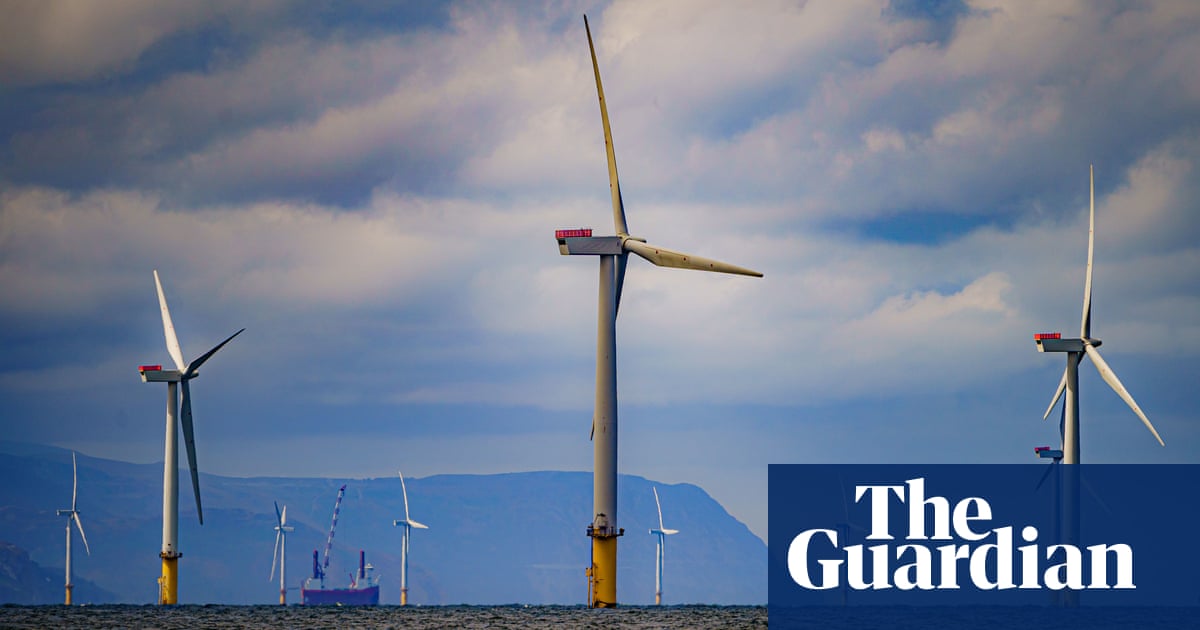Keir Starmer will promise to build enough offshore wind over the next five years to power 20m homes, by using taxpayer money to develop parts of the seabed owned by the royal family.
The prime minister will announce details of the government’s energy generation company, known as Great British Energy, during a visit to the north-west designed to highlight the government’s promises on green energy.
The energy company will be given £8.3bn of public money over the course of the parliament to invest in green technologies, with a target to develop an extra 20-30GW of offshore wind power through a tie-up with the crown estate.
Ministers are hoping that investment will help persuade companies to spend another £60bn in an attempt to hit the government’s target of decarbonising Britain’s power sector by 2030.
Starmer said: “This innovative partnership between Great British Energy and the crown estate is an important step toward our mission for clean energy by 2030, and bringing down energy bills for good.
“This agreement will drive up to £60bn in investment into the sector, turbocharging our country toward energy security, the next generation of skilled jobs, and lowering bills for families and business.”
“This new partnership will help accelerate the deployment of clean energy we need, help generate good jobs in our country and generate wealth for the taxpayer.”
Great British Energy forms the centrepiece of the government’s green agenda, under which ministers are promising to deliver clean power by 2030 and reach net zero by 2050.
The company is modelled on nationalised energy champions such as EDF in France or Sweden’s Vattenfall, though it will not have anything like the spending power of either. It will be created through an act of parliament, which the government hopes will be passed and enacted within months.
While GB Energy will ultimately invest in a range of cutting-edge technologies such as carbon capture, tidal power and small nuclear reactors, its initial focus will be on offshore wind.
Under the plan being launched on Thursday, the company will spend money on activities such as scoping out the seabed and making sure there are connections to the onshore grid to allow private developers to build thousands of new turbines at pace.
The publicly owned company will then keep a stake in the project, using the proceeds either to return money to the government or to invest in further energy projects in the future. Some of the returns however will be used to fund the royal family, which the crown estate was set up for.
Even without Thursday’s announcement, the crown estate already had a target to build between 20 and 30GW of additional offshore wind power by 2030 – more than double what the UK has already installed.
Officials say, however, that without the additional funding and expertise provided by GB Energy it is unlikely to be able to hit that target.
In an article for the Guardian, the energy secretary, Ed Miliband, said: “The crown estate, which has a £16bn portfolio of land and seabed and returns its profits to the government, will bring its long-established expertise having enabled the UK as world leader in offshore wind and the new borrowing powers recently announced by government.
“Great British Energy will bring the strategic industrial policy that the state can provide, as well as its own ability to invest.”
While in opposition, Labour promised to spend £28bn a year on green investment, but reduced that ambition by half as it came under pressure not to promise anything that might require higher taxes.
The move disappointed many green experts, economists and industrialists when Rachel Reeves announced the cut early this year. She was determined to avoid accusations of “tax and spend”, despite the verdict of economists that borrowing for these purposes would generate money in the medium term.
However, the government’s deal with the crown estate, which will have new powers to borrow money and invest, allows Miliband to sidestep some of the Treasury’s strict public finance rules.
Jess Ralston, head of energy at the Energy and Climate Intelligence Unit thinktank, said: “The involvement of the crown estate could be an interesting way of getting round Treasury limitations. The crown estate is already a trusted body in the green energy space, with relationships already with many developers, bringing some certainty to investments.”
Officials are also hoping the link to the royal family will help win support for the new scheme from even Conservative voters, saying they want to ensure the institution is seen as non-partisan and therefore survives any future change of government.
Mathew Lawrence, the head of the thinktank Common Wealth, said: “By giving it greater planning and investment scope, the [deal with the crown estate] will help supercharge GB Energy and develop homegrown clean power.”
But he also urged ministers to allow the company to supply customers directly, something the government has so far ruled out.
“By adding a retail option, so that GB Energy can supply households directly, we can ensure the benefits of the deal are passed directly on to households,” he said.
